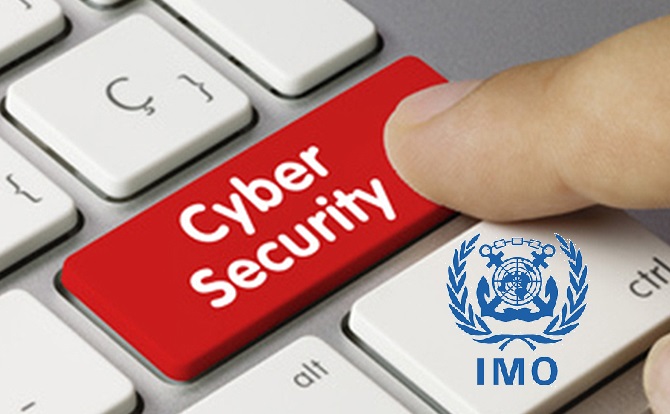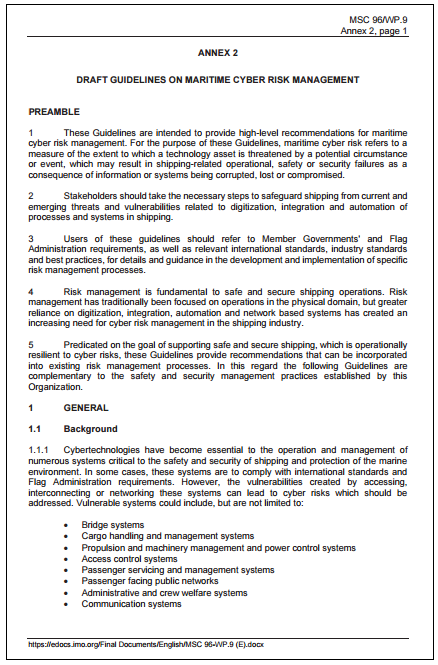
The IMO developed draft guidelines on maritime cyber risk management to provide high-level recommendations to reduce the risk experienced by a technology asset.
PREAMBLE
- These Guidelines are intended to provide high-level recommendations for maritime cyber risk management. For the purpose of these Guidelines, maritime cyber risk refers to a measure of the extent to which a technology asset is threatened by a potential circumstance or event, which may result in shipping-related operational, safety or security failures as a consequence of information or systems being corrupted, lost or compromised.
- Stakeholders should take the necessary steps to safeguard shipping from current and emerging threats and vulnerabilities related to digitization, integration and automation of processes and systems in shipping.
- Users of these guidelines should refer to Member Governments' and Flag Administration requirements, as well as relevant international standards, industry standards and best practices, for details and guidance in the development and implementation of specific risk management processes.
- Risk management is fundamental to safe and secure shipping operations. Risk management has traditionally been focused on operations in the physical domain, but greater reliance on digitization, integration, automation and network based systems has created an increasing need for cyber risk management in the shipping industry.
- Predicated on the goal of supporting safe and secure shipping, which is operationally resilient to cyber risks, these Guidelines provide recommendations that can be incorporated into existing risk management processes. In this regard the following Guidelines are complementary to the safety and security management practices established by this Organization.
1 GENERAL
1.1 Background
1.1.1 Cybertechnologies have become essential to the operation and management of numerous systems critical to the safety and security of shipping and protection of the marine environment. In some cases, these systems are to comply with international standards and Flag Administration requirements. However, the vulnerabilities created by accessing, interconnecting or networking these systems can lead to cyber risks which should be addressed. Vulnerable systems could include, but are not limited to:
- Bridge systems
- Cargo handling and management systems
- Propulsion and machinery management and power control systems
- Access control systems
- Passenger servicing and management systems
- Passenger facing public networks
- Administrative and crew welfare systems
- Communication systems
1.1.2 The distinction between information technology and operational technology systems should be considered. Information technology systems may be thought of as focusing on the use of data as information. Operational technology systems may be thought of as focusing on the use of data to control or monitor physical processes. Furthermore, the protection of information and data exchange within these systems should be considered.
1.1.3 While these technologies and systems provide significant efficiency gains for the maritime industry, they also present risks to critical systems and processes linked to the operation of systems integral to shipping. These risks may result from vulnerabilities arising from inadequate operation, integration, maintenance and design of cyber-related systems, and from intentional and unintentional cyberthreats.
1.1.4 Threats are presented by malicious actions (e.g. hacking or introduction of malware) or the unintended consequences of benign actions (e.g. software maintenance or user permissions). In general, these actions expose vulnerabilities (e.g. outdated software or ineffective firewalls) or exploit a vulnerability in operational or information technology. Effective cyber risk management should consider both kinds of threat.
1.1.5 Vulnerabilities can result from inadequacies in design, integration and/or maintenance of systems, as well as lapses in cyberdiscipline. In general, where vulnerabilities in operational and/or information technology are exposed or exploited, either directly (e.g. weak passwords leading to unauthorized access) or indirectly (e.g. the absence of network segregation), there can be implications for security and the confidentiality, integrity and availability of information. Additionally, when operational and/or information technology vulnerabilities are exposed or exploited, there can be implications for safety, particularly where critical systems (e.g. bridge navigation or main propulsion systems) are compromised.
1.1.6 Effective cyber risk management should also consider safety and security impacts resulting from the exposure or exploitation of vulnerabilities in information technology systems. This could result from inappropriate connection to operational technology systems or from procedural lapses by operational personnel or third parties, which compromise these systems (e.g. inappropriate use of removable media such as a memory stick).
1.1.7 Further information regarding vulnerabilities and threats can be found in the additional guidance and standards referenced in section 3.
1.1.8 These rapidly changing technologies and threats make it difficult to address these risks only through technical standards. As such, these Guidelines recommend a risk management approach to cyber risks that is resilient and evolves as a natural extension of existing safety and security management practices.
1.1.9 In considering potential sources of threats and vulnerabilities as well as potential risk mitigation strategies, organizations should consider a number of potential control options for cyber risk management. Included amongst those possible controls are management controls, operational or procedural controls, and technical controls.
1.2 Application
1.2.1 These Guidelines are primarily intended for all organizations in the shipping industry, and are designed to encourage safety and security management practices in the cyber domain.
1.2.2 Recognizing that no two organizations in the shipping industry are the same, these Guidelines are expressed in broad terms in order to have a widespread application. Ships with limited cyber-related systems may find a simple application of these Guidelines to be sufficient; however, ships with complex cyber-related systems will require a greater level of care and should seek additional resources through reputable industry and Government partners.
1.2.3 These Guidelines are recommendatory.
2 ELEMENTS OF CYBER RISK MANAGEMENT
2.1 For the purpose of these guidelines, cyber risk management means the process of identifying, analysing, assessing, and communicating cyber-related risk and accepting, avoiding, transferring, or mitigating it to an acceptable level considering costs and benefits of actions taken to stakeholders.
2.2 The goal of maritime cyber risk management is to support safe and secure shipping, which is operationally resilient to cyber risks.
2.3 Effective cyber risk management should start at the senior management level. Senior management should embed a culture of cyber risk awareness into all levels of an organization and ensure a holistic and flexible cyber risk management regime that is in continuous operation and constantly evaluated through effective feedback mechanisms.
2.4 One accepted approach to achieve the above is to comprehensively assess and compare an organization's current, and desired, cyber risk management postures. Such a comparison may reveal gaps that can be addressed to achieve risk management objectives through a prioritized cyber risk management plan. This risk-based approach will enable an organization to best apply its resources in the most effective manner.
2.5 These Guidelines present the functional elements that support effective cyber risk management. These functional elements are not sequential – all should be concurrent and continuous in practice and should be incorporated appropriately in a risk management framework:
- Identify: Define personnel roles and responsibilities for cyber risk management and identify the systems, assets, data and capabilities that when disrupted pose risks to ship operations.
- Protect: Implement risk control processes and measures, and contingency planning to protect against a cyberevent and ensure continuity of shipping operations.
- Detect: Develop and implement activities necessary to detect a cyberevent in a timely manner.
- Respond: Develop and implement activities and plans to provide resilience and to restore systems necessary for shipping operations or services impaired due to a cyberevent.
- Recover: Identify measures to back-up and restore cybersystems necessary for shipping operations impacted by a cyberevent.
2.6 These functional elements encompass the activities and desired outcomes of effective cyber risk management across critical systems affecting maritime operations and information exchange, and constitute an ongoing process with effective feedback mechanisms.
2.7 Effective cyber risk management should ensure an appropriate level of awareness of cyber risks at all levels of an organization. The level of awareness and preparedness should be appropriate to roles and responsibilities in the cyber risk management system.
3 BEST PRACTICES FOR IMPLEMENTATION OF CYBER RISK MANAGEMENT
3.1 The approach to cyber risk management described herein provides a foundation for better understanding and managing cyber risks, thus enabling a risk management approach to address cyberthreats and vulnerabilities. For detailed guidance on cyber risk management, users of these guidelines should also refer to Member Governments' and Flag Administration requirements, as well as relevant international standards, industry standards and best practices.
3.2 Additional guidance and standards may include, but is not limited to:
- The Guidelines on Cyber Security on board Ships by BIMCO, CLIA, ICS, INTERCARGO and INTERTANKO.
- ISO/IEC 27001 standard on Information technology – Security techniques – Information security management systems – Requirements. Published jointly by the International Organization for Standardization (ISO) and the International Electrotechnical Commission (IEC).
- United States National Institute of Standards and Technology's Framework for Improving Critical Infrastructure Security (the NIST Framework).
3.3 Reference should be made to the most current version of any guidance or standards utilized.
_____________________________
Click below image to download full IMO guidance:
For more cyber-security related Guides and circulars, click here.
Source: IMO















